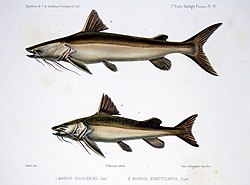Piraíba
|
Brachyplatystoma Temporal range: Middle Miocene - Recent |
|
|---|---|
 |
|
| The fish at top is a Brachyplatystoma rousseauxii, and that below is an unidentified Brachyplatystoma | |
| Scientific classification | |
| Kingdom: | Animalia |
| Phylum: | Chordata |
| Class: | Actinopterygii |
| Order: | Siluriformes |
| Family: | Pimelodidae |
| Tribe: | Brachyplatystomatini |
| Genus: |
Brachyplatystoma Bleeker, 1862 |
| Species | |
|
See text. |
|
| Synonyms | |
See text.
Brachyplatystoma is a genus of catfish from the family Pimelodidae. As the occasionally used common name goliath catfishes indicates, this genus includes some of the largest species of catfish, including the Piraíba, B. filamentosum, which reaches up to the region of 3.6 metres (12 ft) in length. Brachyplatystoma are found in the Amazon and Orinoco basins, and other tropical freshwater and brackish habitats in South America. Some species are migratory. These fish are important as food fish and, to some extent, aquarium fish.
Brachyplatystoma originates from Greek brachys, platys, and stoma, which mean short, flat, and mouth respectively. This genus was described in 1862 by Pieter Bleeker. The type species is B. vaillantii. The subgenus Malacobagrus is applied to B. capapretum, B. filamentosum, B. rousseauxii, and the extinct species B. promagdalena, which only is known from fossil remains.
Brachyplatystoma and its monotypic sister group Platynematichthys are the only genera in the tribe Brachyplatystomatini. These two genera are characterized by two synapomorphies; these include a gas bladder divided into an anterior portion and a triangular posterior portion, as well as a ventral crest under the cleithrum, the main bone supporting the pectoral fins.
...
Wikipedia
